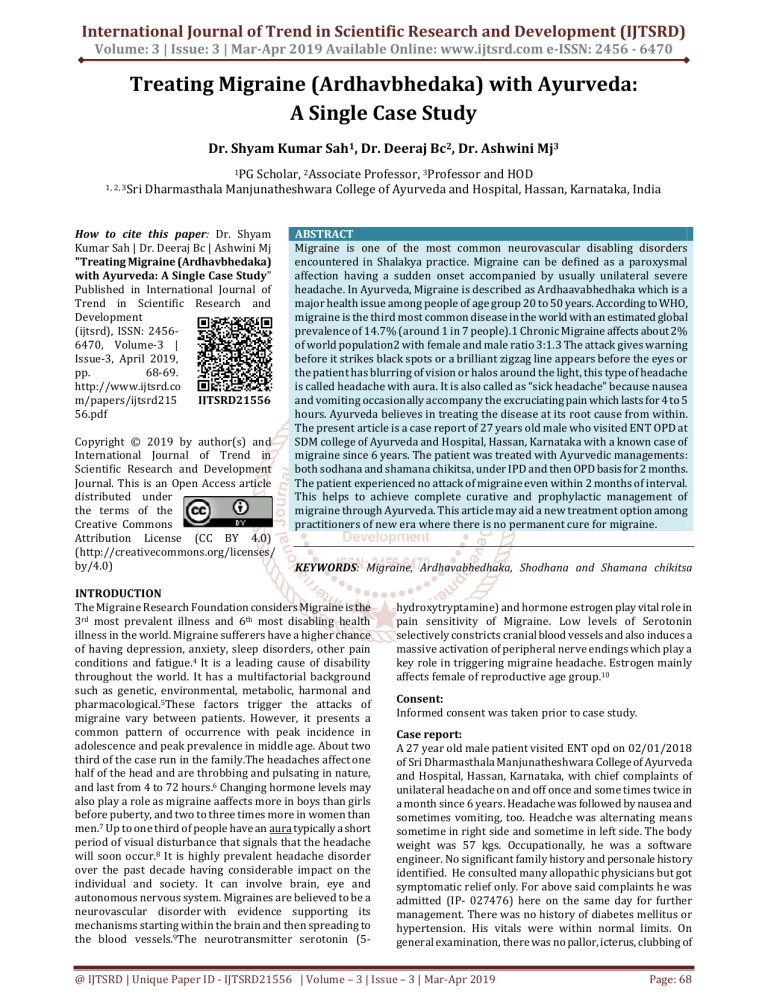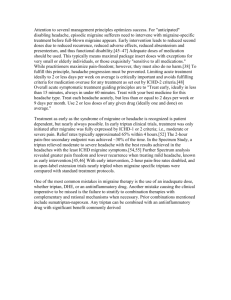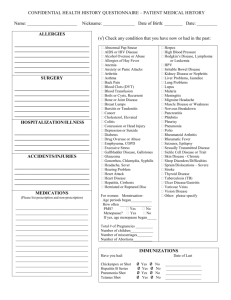
International Journal of Trend in Scientific Research and Development (IJTSRD) Volume: 3 | Issue: 3 | Mar-Apr 2019 Available Online: www.ijtsrd.com e-ISSN: 2456 - 6470 Treating Migraine (Ardhavbhedaka) with Ayurveda: A Single Case Study Dr. Shyam Kumar Sah1, Dr. Deeraj Bc2, Dr. Ashwini Mj3 1PG Scholar, 2Associate Professor, 3Professor and HOD 1, 2, 3Sri Dharmasthala Manjunatheshwara College of Ayurveda and Hospital, Hassan, Karnataka, India How to cite this paper: Dr. Shyam Kumar Sah | Dr. Deeraj Bc | Ashwini Mj "Treating Migraine (Ardhavbhedaka) with Ayurveda: A Single Case Study" Published in International Journal of Trend in Scientific Research and Development (ijtsrd), ISSN: 24566470, Volume-3 | Issue-3, April 2019, pp. 68-69. http://www.ijtsrd.co m/papers/ijtsrd215 IJTSRD21556 56.pdf Copyright © 2019 by author(s) and International Journal of Trend in Scientific Research and Development Journal. This is an Open Access article distributed under the terms of the Creative Commons Attribution License (CC BY 4.0) (http://creativecommons.org/licenses/ by/4.0) ABSTRACT Migraine is one of the most common neurovascular disabling disorders encountered in Shalakya practice. Migraine can be defined as a paroxysmal affection having a sudden onset accompanied by usually unilateral severe headache. In Ayurveda, Migraine is described as Ardhaavabhedhaka which is a major health issue among people of age group 20 to 50 years. According to WHO, migraine is the third most common disease in the world with an estimated global prevalence of 14.7% (around 1 in 7 people).1 Chronic Migraine affects about 2% of world population2 with female and male ratio 3:1.3 The attack gives warning before it strikes black spots or a brilliant zigzag line appears before the eyes or the patient has blurring of vision or halos around the light, this type of headache is called headache with aura. It is also called as “sick headache” because nausea and vomiting occasionally accompany the excruciating pain which lasts for 4 to 5 hours. Ayurveda believes in treating the disease at its root cause from within. The present article is a case report of 27 years old male who visited ENT OPD at SDM college of Ayurveda and Hospital, Hassan, Karnataka with a known case of migraine since 6 years. The patient was treated with Ayurvedic managements: both sodhana and shamana chikitsa, under IPD and then OPD basis for 2 months. The patient experienced no attack of migraine even within 2 months of interval. This helps to achieve complete curative and prophylactic management of migraine through Ayurveda. This article may aid a new treatment option among practitioners of new era where there is no permanent cure for migraine. KEYWORDS: Migraine, Ardhavabhedhaka, Shodhana and Shamana chikitsa INTRODUCTION The Migraine Research Foundation considers Migraine is the 3rd most prevalent illness and 6th most disabling health illness in the world. Migraine sufferers have a higher chance of having depression, anxiety, sleep disorders, other pain conditions and fatigue.4 It is a leading cause of disability throughout the world. It has a multifactorial background such as genetic, environmental, metabolic, harmonal and pharmacological.5These factors trigger the attacks of migraine vary between patients. However, it presents a common pattern of occurrence with peak incidence in adolescence and peak prevalence in middle age. About two third of the case run in the family.The headaches affect one half of the head and are throbbing and pulsating in nature, and last from 4 to 72 hours.6 Changing hormone levels may also play a role as migraine aaffects more in boys than girls before puberty, and two to three times more in women than men.7 Up to one third of people have an aura typically a short period of visual disturbance that signals that the headache will soon occur.8 It is highly prevalent headache disorder over the past decade having considerable impact on the individual and society. It can involve brain, eye and autonomous nervous system. Migraines are believed to be a neurovascular disorder with evidence supporting its mechanisms starting within the brain and then spreading to the blood vessels.9The neurotransmitter serotonin (5- hydroxytryptamine) and hormone estrogen play vital role in pain sensitivity of Migraine. Low levels of Serotonin selectively constricts cranial blood vessels and also induces a massive activation of peripheral nerve endings which play a key role in triggering migraine headache. Estrogen mainly affects female of reproductive age group.10 Consent: Informed consent was taken prior to case study. Case report: A 27 year old male patient visited ENT opd on 02/01/2018 of Sri Dharmasthala Manjunatheshwara College of Ayurveda and Hospital, Hassan, Karnataka, with chief complaints of unilateral headache on and off once and some times twice in a month since 6 years. Headache was followed by nausea and sometimes vomiting, too. Headche was alternating means sometime in right side and sometime in left side. The body weight was 57 kgs. Occupationally, he was a software engineer. No significant family history and personale history identified. He consulted many allopathic physicians but got symptomatic relief only. For above said complaints he was admitted (IP- 027476) here on the same day for further management. There was no history of diabetes mellitus or hypertension. His vitals were within normal limits. On general examination, there was no pallor, icterus, clubbing of @ IJTSRD | Unique Paper ID - IJTSRD21556 | Volume – 3 | Issue – 3 | Mar-Apr 2019 Page: 68 International Journal of Trend in Scientific Research and Development (IJTSRD) @ www.ijtsrd.com eISSN: 2456-6470 nails, oedema or lymphadenopathy noted. No CNS abnormalities noted on through examination. Investigations: Routine haematological and urine investigations as well as CT scan of brain were carried out and findings were not of any pathological significance. The visual acuity of both eyes were 6/6, Right eye 6/6 , Left eye 6/6 and near vision N6 as well as IOP 14mm of Hg in both eye were observed before and after treatment. Treatment Protocol: 1st Day: the patient was given amapachanna with chitrakadivati in the dose of 2 tablets and Panchakolaphanta 100ml tid followed by kriyakalpa procedures Sthanika Avagundana with Dhanyaka and Haridra in Triphala kashaya over fronto-maxillary region OD. Rasna choorna was applied over fore head. 2nd Day: Sadhyovireachana with Nimbamritadi Erand taila 60ml followed by Triphala kashaya 100ml was given on empty stomach at 8 a.m. Sips of hot water and Jeera jala were also given. The patient had four vegas of virechana on that day. Sthanika avagundana was given at 4 p.m. 3rd Day: Mukha abhyanga with Asanbilwadi taila followed swedana karma. Marsha nasya with Anu taila, 12-12 drops in each nostril followed by haridra and ghrita dhumapana in the morning on empty stomach. Shirotalam with Brahmi churna, Bala churna and Aswgandha churna in Satapaka taila was applied. Sthanika Avagundana was given in the afternoon. These treatment protocols continued for 7 days along with internal medication like tab. Cephagraine 2 tid, Madiphala Rasayan 2 tsf tid with water and Sirasuladi Vajra Rasa 2 bd after food. Rasna Choorna for sirolepa was given. 10th Day: Patient was discharged and advised to continue tab. Cephagraine 2 tid, Madiphala Rasayan 2 tsf tid with water and Sirasuladi Vajra Rasa 2 bd after food. Rasna Choorna for sirolepa SOS for 20 days as well as to avoid apathya and triggering factors. 1st Follow up: after 20th day patient came to ENT opd with no attacks of migraine. He was advised to continue the same for 1 month. 2nd Follow up: after one month from the date of 1st follow up, he came to ENT opd with no attacks of migraine. He was advised to continue tab. Cephagraine 2 tid and Madiphala Rasayan 2 tsf tid for one month more and follow up next month. But patient did not come for 3rd follow up. Results: Significant changes in signs and symptoms were noticed before treatment and after treatment with short course duration of 7 days. On first day, patient had severe right sided headache which reduced on third day. On 10th, he had no headache and was feeling happy. On 1st and 2nd follow up there was no attacks of migraine in between the course of duration. Discussion: Ayurveda believes in treating the disease at its root cause from within. According to clinical features of the patient, the headache was Migraine without aura i.e. common migraine. This type of migraine is very common and does not have any warning signs. Migrain can be closely related to ardhavbhedaka in Ayurveda explained by commentator Chakrapani as Ardhamastaka vedna due to its cardinal feature ‘half sided headache’.11 Sodhana and Shamana both therapy were given to the patient for the treatment. Sadhyovirechana with Nimbamritadi Erand taila detoxifies the body and removes the vitiated pitta Doshas from the kosta. Nasya karma with Anu taila was instilled into both nostrils and was expected to strengthen the vital functions of the sense organs by its unique mode of action through Shringataka marma. Sthanika avagundana the special kriyakalpa procedure helped to open the Vatavaha shrotas and lightened the head. The ingredients used for avagundana Dhanyaka, Haridra and Triphala kashaya was supposed to pacify vitiated vata-kapha Doshas. Similarly, Rasna choorna sirolepa was having potent vatahara properties. The internal medications also helped to pacify the vitiated Doshas and brought into the equilibrium state. The combination of both sodhana and shamana therapies were acted synergistically to combat against the vitiated tridoshas in pathology of Ardhavbhedaka. Conclusion: Migraine is an episodic neurovascular disabiling disorder which is closely related to ardhavbhedaka in Ayurveda and characterized by its cardinal feature half sided headache. Ayurveda believes in cleansing the body and pacifying the tridoshas from the roots by using unique treatment modalities such as sodhana and shamana chikitsa. These treatment approaches create a balanced physiology which brings healing the body and mind. This helps to achieve complete treatment as well as control of migraine to the patient. Ayurveda opens new doors for treatment of migraine through holistic approaches and aid a new treatment option among practitioners of new era where there is no permanent cure for migraine References: [1] Steiner TJ et al. Migraine: the seventh disabler. The Journal of Headache and Pain 2013, 14:1 [2] Natoli JL et al. Global prevalence of chronic migraine: a systematic review. Cephalgia. 2010 May; 30 (5): 599609 [3] WHO. Atlas of headache disorders and resources in the world 2011. [4] http://migraineresearchfoundation.org/aboutmigraine/migraine-facts/ [5] WHO. Atlas of headache disorders and resources in the world 2011. [6] https://en.m.wikipedia.org>wiki>Migraine [7] Bartleson JD, Cutrer FM (May 2010). "Migraine update. Diagnosis and treatment". Minn Med. 93 (5): 36– 41. PMID 20572569 [8] Headache Classification Subcommittee of the International Headache Society (2004). "The International Classification of Headache Disorders: 2nd edition". Cephalalgia. 24 (Suppl 1): 9–160. PMID 14979299 [9] Bartleson JD, Cutrer FM (May 2010). "Migraine update. Diagnosis and treatment". Minn Med. 93 (5): 36– 41. PMID 20572569 [10] Hamel, E. (November 2007). "Serotonin and migraine: biology and clinical implications". Cephalalgia: An International Journal of Headache. 27 (11): 1293– 1300. PMID 17970989 [11] Agnivesha. 2011. Charak Samhita revised by Charak and Drudhabala with Ayurveda Dipika Commentary by Chakrapani Datta; Edited by Vaidya Yadavji Trikamji Acharya, published by Chaukhamba Prakashan Varanasi. @ IJTSRD | Unique Paper ID - IJTSRD21556 | Volume – 3 | Issue – 3 | Mar-Apr 2019 Page: 69


